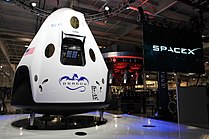商业载人航天发展计画
此条目翻译自英语维基百科,需要相关领域的编者协助校对翻译。 |
商业载人航天发展计画(英语:Commercial Crew Development,缩写:CCDev)始于商业载人发展(CCDev)计划的第二轮,该计划从用于人类航天的技术开发计划扩展到一个竞争性开发计划,该计划将生产可在商业载人计划中使用的航天器 。从2011年开始,NASA以从私人供应商那里购买载人太空船的概念,以载运美国和各国的太空人往返国际太空站(ISS)。2014年9月,SpaceX和波音公司获得了发射太空人升空的运营合同。[1]
两公司都在2019年进行了一次无人的测试飞行。SpaceX载人龙飞船示范1号的龙飞船2号于2019年3月到达国际太空站,并通过海面溅落于大西洋返回地球。由于任务经过时间异常,波音星际航线的轨道飞行测试未能在2019年12月到达太空站,但完成了一些测试目标并执行了安全气囊著陆。因此,波音和NASA已同意在2021年3月重新执行轨道飞行测试(OFT)任务。
在示范飞行完成之前,两家公司均已签约向国际太空站提供六次飞行任务。[2]第一批太空人于2018年8月3日宣布。[3]预计两家公司将从2020年5月由SpaceX率先开始从美国发射太空人升空,但是在2020年4月6日,波音公司宣布将重做其轨道飞行测试,这意味著载人飞行测试将在2021年发射。
任务
编辑| 任务 | 图章 | 太空船 | 描述 | 乘员 | 日期 | 结果 |
|---|---|---|---|---|---|---|
| 龙飞船2号 天龙号太空船C201 (1) |
Pad abort test, Cape Canaveral Air Force Station, Florida | 不适用 | 2015年5月6日 | 成功 | ||
| 龙飞船2号 载人龙飞船C204 (1) |
Uncrewed test flight. DM-1 launched on 2 March 2019 and docked to ISS PMA-2/IDA-2 docking port a little under 24 hours after launch. The Dragon spent five days docked to ISS before undocking and landing on 8 March 2019. | None | 2019年3月2日[4] | 成功 | ||
| 波音星际航线 Spacecraft 1 |
Uncrewed Pad Abort Test | 不适用 | 2019年11月4日 | 成功 | ||
| 波音星际航线 Spacecraft 3 Calypso |
Uncrewed test flight. Was the first flight of an Atlas V with a dual engine Centaur upper stage. Was originally planned to spend eight days docked to ISS before landing. However, Starliner was unable to rendezvous with the station due to the MET anomaly forcing it to enter a lower-than-expected orbit.[5] The spacecraft returned on 22 December 2019 after spending two days in orbit. OFT-2 was proposed to meet all objectives. | None | 2019年12月20日[6] | 部分失败 due to MET anomaly | ||
| 龙飞船2号 C205 (1) |
A Falcon 9 booster launched a Dragon 2 capsule from LC-39A to perform an in-flight abort shortly after Max q in order to test Dragon 2's launch abort system. Abort occurred at 84 seconds after launch and Dragon 2 successfully separated from the Falcon 9 and flew away using its SuperDraco thrusters. The Falcon 9 booster disintegrated as a result of aerodynamic forces. Dragon 2 splashed down nine minutes after launch after successfully deploying its four parachutes. | 不适用 | 2020年1月19日 | 成功 | ||
| 龙飞船2号 奋进号 (1) |
Crewed test flight. Dragon 2 launched with two crew members and dock to the ISS about 18 hours later. Dragon and its crew spent up to 62 days on board the ISS.[7] | 道格拉斯·赫尔利 罗伯特·本肯 |
2020年5月30日 | 成功 | ||
| 波音星际航线 Spacecraft 2 |
Uncrewed test flight. Suggested by Boeing and approved by NASA on July 30,2021 at 2:53 p.m. EDT due to the partial failure of software on the previous Starliner test flight, in particular its failure to reach or dock with the ISS. | 不适用 | 2022年5月19日[8] | 成功 | ||
| 波音星际航线 | Extended crewed test flight. | TBA TBA TBA |
NET 2022第三季度[9] | 计划 |
参见
编辑参考资料
编辑- ^ Bolden, Charlie. American Companies Selected to Return Astronaut Launches to American Soil. NASA.gov. [September 16, 2014]. (原始内容存档于2020-11-11).
- ^ Boeing, SpaceX Secure Additional Crewed Missions Under NASA's Commercial Space Transport Program. [2021-01-03]. (原始内容存档于2020-10-20).
- ^ NASA Assigns Crews to First Test Flights, Missions on Commercial Spacecraft. NASA. August 3, 2018 [2021-01-03]. (原始内容存档于2020-03-20).
- ^ Demo-1 Flight Readiness Concludes. blogs.nasa.gov. [2019-02-22]. (原始内容存档于2020-10-23) (美国英语).
- ^ Bridenstine, Jim. Update: #Starliner had a Mission Elapsed Time (MET) anomaly causing the spacecraft to believe that it was in an orbital insertion burn, when it was not. More information at 9am ET. @JimBridenstine. 2019-12-20 [2019-12-20]. (原始内容存档于2019-12-20) (英语).
- ^ Foust, Jeff. Boeing, SpaceX press towards commercial crew test flights this year. Spacenews. [9 October 2019].
- ^ 存档副本. [2021-01-03]. (原始内容存档于2020-04-24).
- ^ NASA and Boeing Target New Launch Date for Next Starliner Flight Test. Space Coast Daily. 21 July 2021 [22 July 2021]. (原始内容存档于2021-07-22).
- ^ Clark, Stephen. Boeing plans second Starliner test flight in December or January – Spaceflight Now. [2020-09-03]. (原始内容存档于2020-10-23) (美国英语).
外部链接
编辑- Official NASA Commercial Crew Program page(页面存档备份,存于互联网档案馆)
- Official NASA Press Kit relating to the Commercial Crew Program(页面存档备份,存于互联网档案馆)
- Commercial Crew & Cargo Document Library on NASA.gov(页面存档备份,存于互联网档案馆)
- CCDev 1 Space Act agreements(页面存档备份,存于互联网档案馆)
- Partners Mature Spacecraft Designs(页面存档备份,存于互联网档案馆), NASA video update, 14 January 2014.
- Boeing CCtCap Contract (redacted)(页面存档备份,存于互联网档案馆)
- SpaceX CCtCap Contract (redacted)(页面存档备份,存于互联网档案馆)



